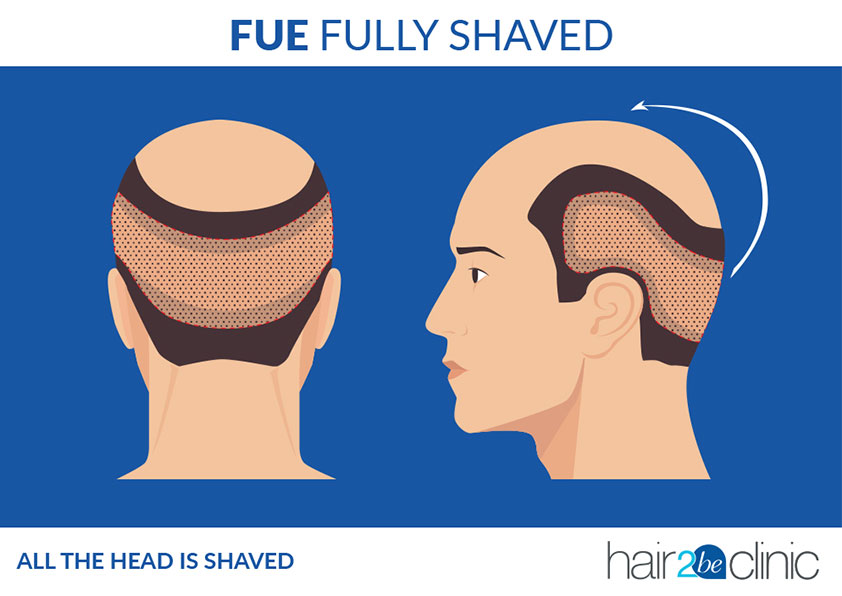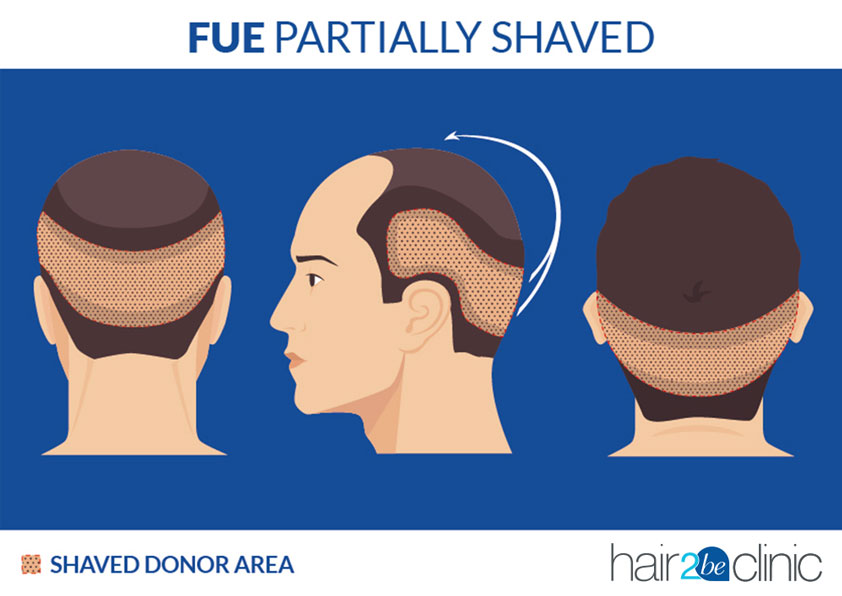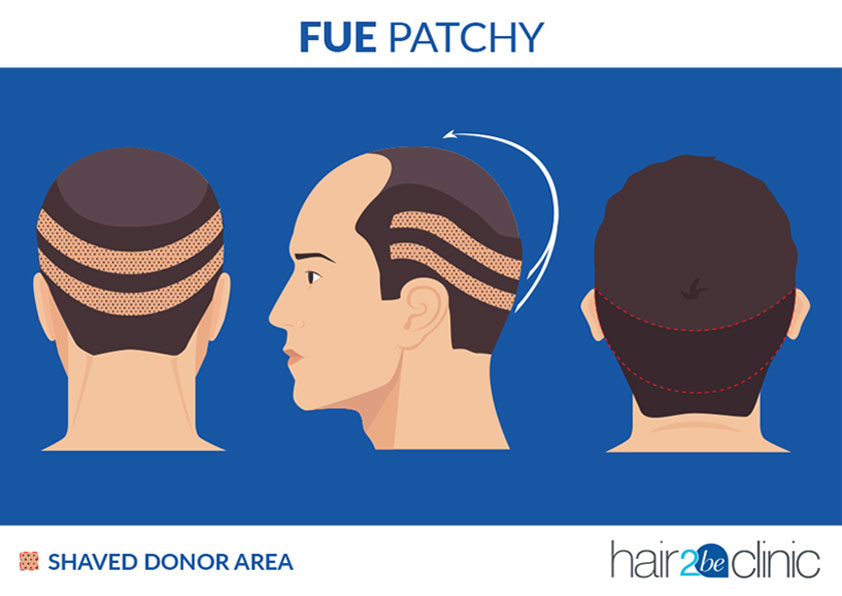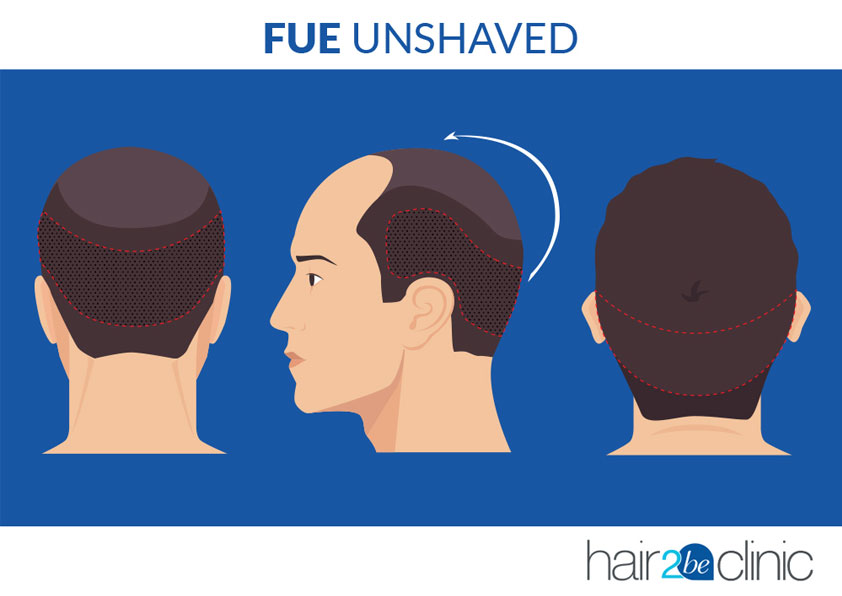FUE Hair Transplantation
Follicular extraction
FUE, (also known as FOX, FIT or Follicular Extraction), is a method that allows us to successively extract each single hair follicle from the donor area towards the area to be treated by use of a mini punch.
Old-school FUE
Traditionally, hair transplant was performed by use of large oscillating punches of about 3 to 5 mm.
This resulted in hair with a « doll-like » aspect to it. Moreover, the donor area showed large round shaped scars.
Although this technique evolved significantly, market research indicated that some clinics still work with this technique, unfortunately.
Next generation FUE
FUE is the culmination of new techniques in hair transplant. It can be used as an individual technique or as an addition to FUT (Follicular Unit Transplantation).
This technique allows us to extract individual follicles from the donor area using micro-punches ranging from 0.8 to 1mm and instantly redistribute these in the recipient area.
Simply put, FUE allows to individually select the best grafts in order to achieve optimal results.
FUE, it’s all about know-how

Follicular extraction requires a great deal of patience and skill. Our know-how is apparent from the exclusive use of these methods and from the use of very specific instruments which allows us to achieve results that match our patients’ expectations.
Traditionally, FUE (Follicular Unit Extraction) was often used for moderate baldness that required only a limited number of grafts (somewhere between 1000 and 2000 grafts/day).
Currently, our techniques and micro graft FUE instruments allow us to perform "mega sessions" which enables us to implant around 2500 to 3000 grafts per day, without compromising quality. Wound healing will take little time and scars will be virtually invisible.
The different steps in FUE
- Micro « coring » : Micro « coring » the follicle units by use of a micro-punch, which ranges in sizes of 0.75 and 1.0 mm. At this stage, the graft remains in position. It is an important moment that will or will not facilitate the next step depending on skill-level.
- Graft harvesting : A very delicate moment where the grafts are extracted using mild tugs applied by two specially designed tweezers. At this stage, it‘s crucial not to damage the bulbs. The grafts will be preserved in a physiological saline solution with a temperature of 4°.
- Graft management : Microscopic graft management. Each harvested graft is registered and stored in the order of the number of hairs it holds.
- The incisions : The incisions are carried out by use of ultra-thin blades selected to fit the grafts’ individual size. They are performed respecting a specific personal pattern and angulation in order to regrow a natural aspect. The number of incisions will be determined by the number of harvested grafts and will depend on the result expected by the patient. The anterior hairline will be restored by incisions that will be recipients for hair grafts.
- Implanting the grafts : A vital step that requires continuous high accuracy. Depth and direction of implantation are of the utmost importance.
Different types of FUE
FUE Fully Shaved
FUE Partially shaved
FUE Patchy
FUE Unshaved
Advantages and constraints
FUE advantages
- FUE is particularly interesting for patients that like to keep their hair short. The thin residual scars, consisting of small dots, disappear more easily in the hair. It offers the possibility to conceal the scar(s) left by former hair transplants or by a former lifting.
- FUE also allows eyebrow restoration. Moreover, it offers patients, whose donor area (occipitotemporal region) has limited density, to find an alternative solution to restoration by harvesting long body hair.
- FUE will provoke fewer post-surgery discomfort and enables you to resume your sports and social activities sooner.
- FUE allows to select follicles of choice in function of the strategy applied in the area to be restored.
FUE constraints
- The donor area needs to be shaved when starting surgery. Unless, however, you opt for FUE Patchy or Unshaved subject to price adaptation.
- Surgery duration is significantly higher than FUT for an equal amount of hairs.
- Follicle unit extraction time is longer than when using FUT : and the laying front-down position during the procedure can be strenuous.
- The donor area from which hairs are harvested is larger than when using FUT. In the long run, graft survival can be less.
- The total scar surface is bigger in comparison to FUT for the same amount of grafts.
- FUE should only be carried out by experienced teams. Follicles are more fragile, requiring a delicate way of picking and require dexterity of the surgeon/technician of both hands and a lot of practice.
Hair2BeClinic
« Every detail matters »

Some of the factors to take into consideration before deciding in order to obtain a successful FUE hair transplant.
Keep in mind that your donor area has a limited number of transferable grafts.
Ask yourself the right questions when deciding
Is the minimum distance between extractions respected ?
Errors of this sort can lead to insufficient residual density and visible scars. Often, at Hair2beClinic, we see patients whose donor zone is completely ruined and in many cases is no longer suitable for a second procedure.
Will the applied implantation strategy offer satisfaction in the long run ?
Offering satisfaction in the long run is every bit as important as offering it now. The implantation strategy needs to take many factors into consideration in order to guarantee a well-balanced redistribution of your donor area. This strategy is all the more important when dealing with young patients.
What is the « actual » diameter of the applied punch ?
Out of complacency or inexperience, there is greater tolerance for transection when increasing the punch diameter. Consequently, scars will be more apparent. When comparing FUE and FUT for a same amount of grafts using adequate management of both techniques, FUE produces scars 3 times as big in diameter as those produced by FUT. Good expertise is required in order to prevent vascularisation (abnormal formation of blood vessels ) in the donor area.
The optimum ratio is a minimum amount of residual scars for a maximum amount of extracted hairs by limiting transections in the donor area. Keep in mind that with FUE each scar is an additional one whereas with FUT, a second procedure will not result in an additional scar as the first one will be replaced by the second and final one.
Are my grafts being subdivided in order to artificially enhance their number ?
We respect integrity of the follicular units in your donor area. These will not be subdivided in order to enhance the final budget. At Hair2beClinic, subdivision will only be performed in case insufficient single-hair follicles, needed to recreate the frontal hairline, are found. In any case, all our actions will be explained in detail in your surgical report.
Have you been offered a detailed description of the procedure ?
This document is a transparency bench mark. It allows you to be informed of every detail regarding your surgery (number of performed transections, average number of hairs per graft, number of extracted grafts,...). This analyses is a time-consuming task for the team as each graft is subject to microscopic analyses. For this reason this step, however important, is often neglected.
FUE and BODY HAIR
Body hairs are used to complement FUT and FUE type transplant when the patient considerably lacks density in the scalp’s donor area. Hence, this technique is complementary to ordinary FUE in order to obtain more natural and more dense results.
It can also be applied to camouflage broader scars due to excessive tension exerted on a FUT and to perform eyebrow hair transplant.
Body hair is harvested from the torso, the axillary region, the pubic area, the back, the shoulders and the calves.
In our experience, we have noted that in certain patients, this technique can be quite convincing leading to a natural look hair aspect, whereas in others the result can be rather disappointing. As a result, a donor area analysis is crucial and we are happy to discuss this option with you if necessary.
We might suggest to perform a preliminary test on 20 to 50 grafts in order to estimate the impact of a more substantial hair transplant.






